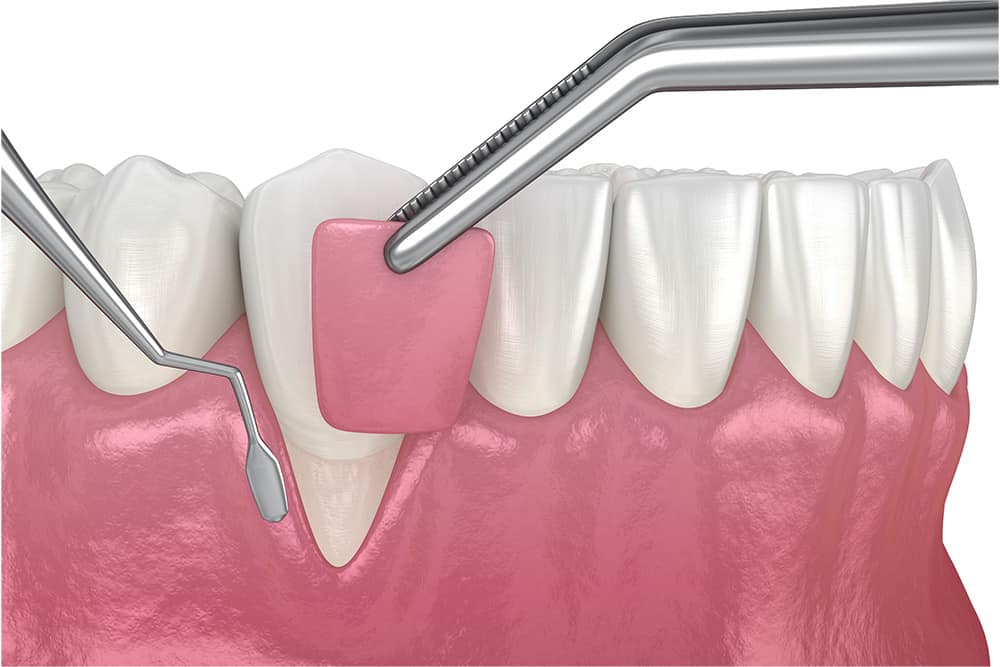Laser Treatment for Receding Gums: Say Goodbye to Tooth Sensitivity!
Enhance Your Smile With Soft Tissue Grafts
Is your smile unappealing due to receding gums?
We can enhance your smile by providing permanent tooth roots coverage with a procedure called soft tissue grafts. Soft-tissue grafting is a standard method to treat receding gums by re-establish your gum line, avoid further degradation of gums, and enhance your smile. It is a minor dental surgical procedure done using your soft tissue or a commercially available option. Soft tissue grafting has better success when performed by periodontists with adequate expertise. Dr. Pradeep Adatrow is a periodontist with more than 17 years of experience in gum treatments and is the best expert to deal with tissue grafts.

4E’s : Benefits of soft tissue grafting for receding gums
- Enhanced comfort – Exposed root conditions and receding gums can contribute to severe pain and discomfort. Soft tissue grafts cover the exposed root, minimize sensitivity, and return the gum to good health.
- Enhanced beauty – A periodontal disease gum recession can lead to a smile that looks irregular. Soft tissue grafting may be used to repair the gums and make the smile more symmetrical.
- Enhanced confidence – Aesthetically pleasing smile and better gum health would improve your confidence in multiple folds.
- Enhanced gum protection - Periodontal condition can damage soft tissue. When used along with the treatment of deep cleaning, soft tissue grafting can reduce tissue and bone deterioration and prevent further exposed roots.
Ready to get started?
Reach us now to schedule your consultation
Frequently Asked Questions on Soft Tissue Grafts
What are soft tissue grafts?
Soft-tissue grafting is a standard method to re-establish your gum line, avoid further degradation of gums, and enhance your smile. It is a minor surgical procedure done by using your soft tissue or a commercially available option.
What are the types of gum grafting (soft tissue grafting)?
These are the types of soft tissue grafts:
- Connective tissue grafts
- Free gingival grafts
- Pedicle grafts
- Hole technique grafts
- Allografts
How is soft tissue grafting performed?
Following steps are involved in performing soft tissue grafting:
- At first, deep cleaning of the teeth and roots is crucial to get rid of calculus (tartar) above and under the gum line.
- The grafting method itself is typically done under local anesthesia but depends on the grafted areas' scale.
- Dr. Adatrow will make a small incision at the receiver's site to create a small pocket.
- This pocket involves a split incision of thickness, and between the two parts of this section, the donor tissue is placed. In general, the strip of the donor tissue is greater than the incision.
- The site might be pre-sutured with a platelet-rich growth factor that stimulates natural tissue growth and promotes good healing.
- Also, proteins that activate tissues may be added to facilitate faster growth of tissue.
- Finally, the wound site will be sutured to stop movement, and surgical material to cover the vulnerable area will be applied.
How long does the healing of soft tissue grafting take?
It might take around four to six weeks for the soft tissue grafting to heal.
What is a gum recession?
In essence, the gingival (gum) recession is the scientific term when the tooth's root is more sensitive gum tissue deteriorates. The more the gums slip down, the more probability the tooth's root becomes exposed, the more complications occur. This causes discomfort, sensitivity, and can cause tooth loss over time.
What are the causes of gum recession?
- Genetics
- Poor oral hygiene
- Improper or aggressive brushing
- Lack of dental treatment
- Advanced gingivitis (gum disease)
What is connective tissue gingival grafting?
In this procedure, A flap skin is elevated from the palate of the mouth, and then a tissue under the surface of the flap is extracted. This tissue is a subepithelial connective tissue which is used to cover the exposed root surfaces. After the removal of connective tissue from the flap, the flap is stitched into its position again.
What is a hole technique of gingival grafting?
A least invasive alternative to the treatment of gingival recession is the hole surgical technique. Compared to soft tissue grafting, this procedure starts by making a minute hole in the receding gum tissue. As soon as the hole is made, a tool is inserted into the hole. The device extends the gum into a more stable and acceptable tooth location. After the gums are relocated, Dr. Adatrow inserts collagen strips into the hole made in the gums. So, while soft tissue grafting utilizes sutures (stitches) to hold the gums in place, these collagen strips secure the gums in the new location in a minimally invasive manner and contribute to creating new tissue that eventually secures the gums in its new position.



